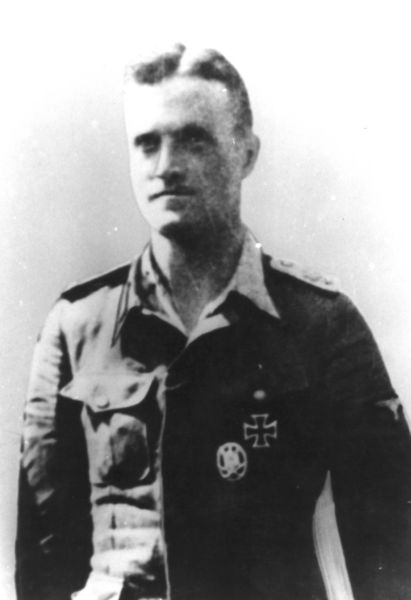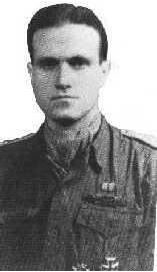Armberger, Josef „Sepp" (Waffen SS)
- Date of birth:
- June 26th, 1920 (Gugging/Lower Austria, Austria)
- Date of death:
- August 21st, 1944 (north east of Mossey, France)
- Buried on:
- German War Cemetery Champigny-St.-André
Grave: UNK. - Service number:
- SS-Nr.: 372.349 // NSDAP-Nr.:
- Nationality:
- Austrian (1938-1945, Reichsgau)
Biography
01.05.1938: SS-Anwärter, entered the SS, SS-Standarte "Der Führer"
00.09.1939: SS-Sturmmann, 1. Kompanie, SS-Infanterie-Regiment 'Der Führer' - campaign in France
00.00.1939: SS-Junkerschule Braunschweig
00.00.1939: SS-Untersturmführer
00.00.1940: SS-Obersturmführer
00.04.1941: campaign in the Balkans - Operation Marita
00.06.1941: SS-Ustuf, Zugführer, 3. Batterie, SS-Flak-Abteilung 1, LSSAH - Operation Barbarossa
Zugführer, 14. Kompanie, SS-Totenkopf-Infanterie-Regiment
00.07.1941: SS-Ustuf, Adjutant, SS-Flak-Abteilung 1, LSSAH
00.11.1941: SS-Ustuf, 3. Batterie, SS-Flak-Abteilung 1, LSSAH
00.02.1943: SS-Ustuf, 4. Batterie, SS-Flak-Abteilung 1, LSSAH
00.03.1943: SS-Ustuf, 5. Batterie, SS-Flak-Abteilung 1, LSSAH
11.03.1943: WIA
13.03.1943: WIA
14.03.1943: WIA
10.04.1943: WIA - sent to SS-Lazarett Vienna
01.06.1943: SS-Ustuf, Chef, 8. Kompanie, SS-Panzer-Regiment 1, LSSAH
00.06.1944: fightings in Saint-Lambert, Tournay-sur-Dive, and Villedieu les Bailleul, Falaise, Normandy
20.08.1944: 4 Sherman tanks knocked out with Panzerfaust
21.08.1944: KIA north east of Mossey, Evreux, France
00.08.1944: posthumously promoted to SS-Hauptsturmführer - RDA 01.08.1944
Do you have more information about this person? Inform us!
- Period:
- Second World War (1939-1945)
- Period:
- Second World War (1939-1945)
- Rank:
- SS-Obersturmführer (Lieutenant)
- Unit:
- SS-Flak-Abteilung, Infanterie-Regiment (mot.) "Leibstandarte SS Adolf Hitler", Leibstandarte SS Adolf Hitler,
- Awarded on:
- October 30th, 1941
- Period:
- Second World War (1939-1945)
- Awarded on:
- August 25th, 1942
- Period:
- Second World War (1939-1945)
- Rank:
- SS-Obersturmführer (Lieutenant)
- Unit:
- Zugführer, 5. Batterie, SS-Flak-Abteilung "Leibstandarte SS Adolf Hitler"
- Awarded on:
- 1942
Awarded somewhere between summer 1942 and summer 1943. Exact date unknown.
- Period:
- Second World War (1939-1945)
- Rank:
- SS-Obersturmführer (Lieutenant)
- Unit:
- Chef, 8. Kompanie, SS-Panzer-Regiment 1, 1. SS-Panzer-Division "Leibstandarte SS Adolf Hitler"
- Awarded on:
- March 8th, 1943
- Period:
- Second World War (1939-1945)
- Awarded on:
- April 11th, 1943
- Period:
- Second World War (1939-1945)
- Rank:
- SS-Obersturmführer (Lieutenant)
- Unit:
- Zugführer, 5. Batterie, SS-Flak-Abteilung "Leibstandarte SS Adolf Hitler"
- Awarded on:
- April 1944
- Period:
- Second World War (1939-1945)
- Rank:
- SS-Obersturmführer (Lieutenant)
- Unit:
- Chef, 8. Kompanie, SS-Panzer-Regiment 1, 1. SS-Panzer-Division "Leibstandarte SS Adolf Hitler"
- Awarded on:
- June 1st, 1944
Awarded in the summer of 1943. Exact date unknown.
- Period:
- Second World War (1939-1945)
- Awarded on:
- June 17th, 1944
- Period:
- Second World War (1939-1945)
- Rank:
- SS-Obersturmführer (Lieutenant)
- Unit:
- Chef, 8. Kompanie, SS-Panzer-Regiment 1, 1. SS-Panzer-Division "Leibstandarte SS Adolf Hitler"
- Awarded on:
- June 17th, 1944
- Period:
- Second World War (1939-1945)
- Rank:
- SS-Obersturmführer (Lieutenant)
- Unit:
- Chef, 8. Kompanie, SS-Panzer-Regiment 1, 1. SS-Panzer-Division "Leibstandarte SS Adolf Hitler"
- Awarded on:
- October 31st, 1944
“SS-Obersturmführer Armberger served with the 1. SS-Panzer-Division ‘LSSAH’ from the 15.06.1941 up until his heroic death on the 20.08.1944.
During this time SS-Obersturmführer Armberger was a shining example for officers, NCOs and men alike; he received 9 wounds and was named in the Honour Roll Clasp of the German Army on the 17.06.1944 for his outstanding bravery during the defense of Stanislau.
SS-Obersturmführer Armberger once again effected a disproportionate influence on the combat during the fighting along the Invasion front in the summer of 1944.
English armoured forces launched a surprise thrust along the Carouges—Ranes road on the 13.08.1944, and at around 15:00 they occupied the village of le Menil-Angot. With this the enemy succeeded in blocking the retreat road to the north for those friendly forces that had gathered in the Champ—Jouide Bois area. The enemy was reinforced with additional tanks from the area east of le Menil-Angot and St. Martin, and after this they sought to elongate their blocking line to the east and west.
With this situation in mind, SS-Obersturmführer Armberger received a mission from the commander of the II./SS-Panzer-Regiment 1 ‘LSSAH’. His task was to reconnoiter the enemy force in the le Menil-Angot area with his 5 remaining operational Panzer IVs and 2 armoured cars from the Heer.
SS-Obersturmführer Armberger set out in a swift advance and succeeded in clearing the enemy infantry groups that were occupying the Carrouges—Ranes road. He reached the southern edge of le Menil-Angot, and here his armoured group became engaged in a heavy firefight with the enemy security forces. The enemy furthermore sent in 8 fighter-bombers, and their bombing/strafing attacks rendered impossible any further advance by our armoured spearhead without the latter sustaining heavy losses. New enemy forces came into action at the same time as the fighter-bombers, and SS-Obersturmführer Armberger’s armoured group came under attack from enemy tanks and anti-tank guns. 2 Panzer IVs were lost in the firefight.
SS-Obersturmführer Armberger thereupon decided to break off the battle. He would leave his remaining Panzers to secure the road fork south of le Menil-Angot while he continued his reconnaissance mission on foot with a few comrades.
In order to fulfill this intent, he and his Kompanie squad leader rounded up some of his crew and went forwards against the enemy security position. His objective was to eliminate the enemy tanks on the village edge with close combat weapons and thereby enable his Panzers to launch a renewed attempt against the village.
Despite several unsuccessful attempts he showed great perseverance under the very difficult conditions. He eventually succeeded in working his way into combat range, and from here he personally destroyed 4 enemy tanks in quick succession with Panzerfausts. Throughout this time he put his own life at great risk in order to successfully carry out his ordered mission under any circumstances.
The enemy took heed of his losses, and after this they pulled back their position to a point about 300 metres deeper into the village. From there they were unable to use their weaponry to dominate the road that led southwards from le Menil-Angot. Our own forces were thus able to carry out their ordered withdrawal movements without interference.
The preconditions for this successful maneuver were established by the bold actions and singularly brave initiative of SS-Obersturmführer Armberger.
SS-Obersturmführer Armberger also distinguished himself on multiple other occasions during the Division’s hard battles along the Invasion front. On the 20.08.1944, following his 9th wound, he was struck by a direct artillery hit during the breakthrough battles south of Falaise and died a hero’s death. Here as well he led at the point of his Kompanie against the far superior enemy. This fate overtook him after he had left his vehicle in order to conduct a foot reconnaissance for the operation of his Kompanie.
His death signalled the end of a heroic soldierly life that had served as a model of bravery and courage for all members of the Regiment.
I ask that SS-Obersturmführer Armberger be awarded the Knight’s Cross to the Iron Cross in light of his outstanding achievements throughout all the campaigns of this war.”
Awarded posthumously.
- Period:
- Second World War (1939-1945)
- Period:
- Second World War (1939-1945)
- Awarded on:
- 1944
Sources
- Photo 1: Wehrkundearchiv
- Photo 2:
- Photo: Deutsches Wehrkundearchiv
- - WEGMANN, GÜNTER, Die Ritterkreuzträger der Deutschen Wehrmacht 1939-1945, Biblio-Verlag, 2004.
- Die Ordensträger der Deutschen Wehrmacht (CD), VMD-Verlag GmbH, Osnabrück, 2002
- Fellgiebel, Walther-Peer, Elite of the Third Reich - The Recipients of the Knight's Cross of the Iron Cross 1939-45: A Reference, Helion & Company Limited, England, 2003
- Federl, C., Die Ritterkreuzträger der Deutschen Panzerdivisionen 1939-1945, VDM Heinz Nickel, Zweibrücken, Germany, 2000
- Berger, F., Ritterkreuzträger aus Österreich und den k.u.k. Kronländern, Selbstverlag Florian Berger, Wien, Österreich, 2006
- Axis Biographical Research
- Die Ritterkreuztrager
- Microfilm Publication A3343. US National Archives. - Josef Armberger | Gräbersuche-Online
















